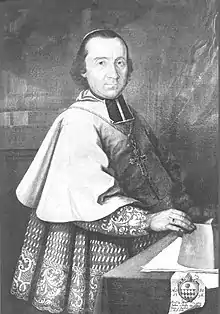Joseph Anton Blatter
Joseph Anton Blatter (in French: Joseph-Antoine Blatter; 8 March 1745 — 19 March 1807) was a swiss prelate who ruled the République des Sept-Dizains, in the modern Canton of Valais, as the 73rd and last Prince-bishop of the Diocese of Sion, from 1790 to 1799, and after the French invasion and dissolution of the republic, as Bishop of Sion until his death in 1807.
Joseph Anton Blatter | |
|---|---|
| Bishop of Sion Count and Prefect of the Valais | |
 Blatter in 1796 | |
| Diocese | Sion |
| Elected | 3 August 1790 |
| Installed | 1790 |
| Term ended | 1799 (continued until 1807 as Bishop) |
| Predecessor | Franz Melchior Zen-Ruffinen |
| Successor | Joseph-François-Xavier de Preux |
| Orders | |
| Consecration | 13 February 1791 |
| Personal details | |
| Born | 8 March 1745 Visp, Republic of the Seven Tithings |
| Died | 19 March 1807 Sion, Rhodanic Republic |
His reign was marked by the turmoil generated by the French Revolution, insurrections in the french-speaking Lower Valais, and the French invasion of Switzerland, culminating in the end of the bishop's secular power and of the ancien régime in Valais.
Life
Blatter was born in Visp, the son of Anna Maria Schiner, from Ernen, and Johann Arnold Blatter. His great-uncle was the then-bishop Johann Joseph Blatter (1684-1752). He had his early education in Brig and Sion, and later studied philosophy in Lyon and theology in Vienna. In 1769 he was ordained as priest in Vienna and, in the same year, as canon in Sion.[1]
He was elected Prince-bishop of the diocese on 3 August 1790, and consecrated in the Cathedral of Sion on 12 February 1791.[2] Two years prior to his election, in 1788, a great fire had swept through Sion, destroying most of the city, including the residence of the prince-bishop, the Château de Tourbillon. Although Blatter by 1793 had plans to rebuild it, the politic upheavels and the French invasion ended any possibility for such project[3] In the period from 1792 to 1794 he gave asylum to many clergy and lay people fleeing from the Reign of Terror in France, including a Trappist and a Poor Clare convent.[1]
In 1798, after the revolution became widespread in the Lower Valais, on March 16, a constituent assembly proclaimed at the Abbey of Saint-Maurice the short lived République des Dix Dizains: the three dizains of Monthey, Saint-Maurice and Entremont joined the top seven dizains.[4] Few months later, after the French invasion under the Directoire, the Valais was incorporated into the newly created Helvetic Republic. Following the crushing of the last revolt in the Upper Valais againt French occupation in the Battle of Finges, in May 1799, Blatter went into exile in Novara for months.[1]
In 1805, he offered his resignation to the Holy See, which was denied by Pope Pius VII.[1] He died in Sion, on 19 March 1807, and was succeeded as bishop by Joseph-François-Xavier de Preux.[2]
See also
References
- Gregor Zenhäusern, Dictionnaire Historique de la Suisse. "Joseph-Antoine Blatter" (in French). Translated by Françoise Senger.
- Société d'histoire de la Suisse romande (1863). Mémoires et documents, volume 18. p. 500.
- "Les travaux de réfection de Tourbillon viennent de debuter !". Journal et feuille d’avis du Valais. 8 September 1963.
- Rachel Siggen-Bruttin, Dictionnaire Historique de la Suisse. "Dizains" (in French).